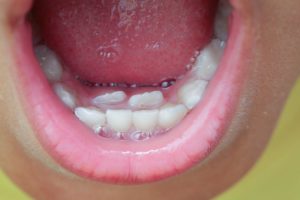Here’s what to Do If Your Child Develops “Shark Teeth”
April 28, 2021

As a parent, you already know that despite your best efforts, things don’t always go the way they’re expected to. For example, your child’s highly-anticipated permanent teeth may start to come in before the baby teeth have fallen out! This unusual phenomenon is called “shark teeth” since sharks also grow rows of pearly whites. Two rows of teeth in kids may seem somewhat alarming at first, but they’re usually no cause for alarm. Here’s everything you need to know about shark teeth in children and how to keep your child’s smile on track if they develop them!
What Causes Rows of Teeth in Kids?
Ideally, when a permanent tooth begins to come in, it dissolves the roots of the baby tooth above it. Naturally, this will cause the baby tooth to fall out and make room for the incoming adult tooth. However, if a permanent tooth develops at a slight angle, it may not weaken the roots of the baby tooth and instead erupt behind it. Alternatively, some studies suggest that sometimes the baby tooth roots won’t dissolve properly, holding the primary tooth firmly in place and forcing the adult tooth to come in behind it.
When Do Shark Teeth in Kids Develop?
Shark teeth can potentially develop at any point as your child’s permanent teeth begin to come in and replace their baby teeth. That being said, there appears to be two periods of time during oral development when shark teeth are most likely to occur. The first is when the lower permanent teeth begin to come in around the age of six, and the second is when the upper back molars begin to come in around the age of 11.
What Should I Do If My Child Has Rows of Teeth?
While rows of teeth in your little one’s precious smile may be alarming at first, they’re rarely a sign of anything serious. In fact, they can generally be safely and easily resolved at home in a majority of cases. First, check to see if the baby tooth is loose. If it is, encourage your child to wiggle it until it falls out. Then, the permanent tooth will have room to come in and your child’s tongue will naturally push it forward into place over time.
However, what should you do if the baby tooth isn’t loose? If the primary tooth is still firmly in place a few weeks after the shark teeth have begun to develop, or your child is complaining about dental pain, it’s time to call your Auburn pediatric dentist. They’ll perform a visual exam and take X-rays to see if the baby tooth is likely to fall out on its own. They will also be checking the surrounding teeth and jawbone for signs of developing shark teeth that you may not be able to see yet. If the baby tooth needs some help making way for the permanent tooth, they may recommend a tooth extraction. After this quick procedure, the permanent tooth will be able to come in properly.
Life is full of the unexpected, even when it comes to your child’s teeth! Whether they’ve begun to develop shark teeth or you’re simply concerned about how their permanent teeth are coming in, don’t hesitate to contact your Auburn pediatric dentist. They’ll make sure that your child gets the gentle, specialized care they need to keep their oral development on track!
About the Practice
New England Kids Pediatric Dentistry and Orthodontics is pleased to offer gentle and fun pediatric and orthodontic services to the growing smiles of Auburn and the surrounding communities. Their combination of advanced training and specialized services ensures that your child gets all the individualized care that they need to keep their oral development on track. If you’re concerned about shark teeth, don’t hesitate to contact them via their website or at (508) 832-6278.
No Comments
No comments yet.
RSS feed for comments on this post.
Sorry, the comment form is closed at this time.


